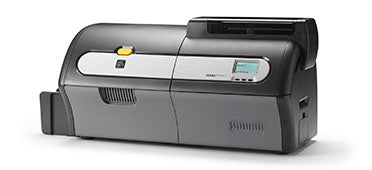ID Cards are an effective way to blend security, culture, and awareness within any organization.
So, you have been tasked with putting together a Photo ID program for your company or organization. You’ve gone through the conversations on how you want the card to look, what elements you want the card to include, and what technology your card is going to be based on, but now you have to piece all the equipment together.

At first, this final step can be daunting. There are a lot of different manufacturers out there whom provide similar products for everything you’ll need. Not to mention that there is so much variety in what you can use for putting it all together. The technology jargon can be jarring.
A basic Photo ID System usually consists of:
- Photo ID Printer
- Printer Ribbons/Supplies
- Cards
- Cleaning Kit / Maintenance Kit
- Web Camera or similar camera for taking photos.
- Photo ID Software
To dig further into this, however, each of these products has a lot of technical terms that can confuse you on the path to getting the card and workflow that you desire.
ID Card Printers
Let’s start at the top with the main piece of equipment, the card printer. You’ve got a variety of considerations with this but remember that there are some different technologies involved and some questions you should ask before settling on an answer.
Card Printers come in two types: Direct to Card printers and Retransfer printers. Lithography printing can also be used for cards like gift cards that are printed in large quantities with common attributes but we’ll focus on the technologies that you can bring in to your office for now.
Direct to Card (or DTC) printers are still the most traditional, common, and low-priced digital card printing technology on the market. These printers are often used in the low to mid-level security industry and for most corporate cards or small run photo identification projects. All the DTC printers feature the same process to obtain their printed image using dye sublimation for the colour ink and thermal transfer for the black ink (2 process steps).
The dye sublimation and thermal transfer processes are quite different. Thermal transfer ribbons heat up to transfer the ink directly on to a card, whereas dye sublimation uses the heat to undergo a chemical reaction change that converts the ink into a gaseous state that then permeates the plastic card. The colour is applied to a card in layers. First it will do a pass applying yellow, followed by Magenta, and Cyan. By applying in layers, black colours usually come out as a composite black that doesn’t come out as dark or as sharp. To offset this, a true black thermal ribbon can be used. The only consumable for this type of printer is a printer ribbon. We’ll go more into how the ribbons and colours differ later.
Advantages for Direct to Card:
- Cost
- Variety of Printer Models to choose from
- Cheaper consumables
Retransfer printers use a different process in printing an image on to a card that solely uses dye sublimation, which is then applied to retransfer film before being applied and laminated on to a card surface. By applying the image to a film before the application to a card, the registration of the colours is near perfect
and the process is altogether faster (no multiple passes). This procedure also allows for additional overlays to improve security and durability to a card.
As a result of this simplified procedure, quality can come out stronger and the image can be more durable and be better aligned to the surface of a card. The whole process uses two consumable components: a printer ribbon and retransfer film.

Advantages for Retransfer:
- Higher Quality
- Better precision for the registration
- Cleanliness (cheaper/less maintenance)
- Closer printing of an image near Smart Card chips
- Less errors
- Faster printing
Printer Supplies
Printer Ribbons come in an YMC (yellow, magenta, cyan), YMCK (for retransfer with a black ribbon), or YMCKO order (depending on your printer model and specifications) and these are the main consumable used to imprint the images on your card through a dye sublimation process. You can also purchase solid black (K) ribbons that are meant for applying a thermal layer on the card that come much cheaper and produces a much deeper, truer black. With retransfer printing; you will also need a second consumable called Retransfer film that allows a printer ribbon to apply a reverse image on to the film ahead of application to a card.
Cards are the foundation of your work towards a final printable ID. Aside from the technical and security considerations of what type of card you wish to use (smart card, mag stripe, etc…), there is also a material composition question. The most common type of card is a standard PVC card (Polyvinyl Chloride). These cards are the cheapest and you’ll find that they are the most common, but they do tend to wear down quickly. There are other materials you can use as well. Recycled and Composite cards that make use of Recycled Materials, PET (Polyester), and PC (Polycarbonate) can all be utilized to create a card that works better for your purposes, required longevity, and environment.
Cleaning supplies for your new printer are also necessary to keep your printer running effectively and to avoid any break down. It’s a good idea to stock some cleaning cards (which are used to clean the print head in case it gums up with residue) and to get some cleaning sleeves and rollers (to check that the internal workings of your printer in general are clear) to keep things running smoothly.
Photo ID Camera
If you’re needing a high-end, professional setup for your photo ID workflow, or you just want to keep a webcam on a Human Resource person’s desk – it’s important to sort out what camera will suit your needs. Often, a standard Digital SLR (Single Lens Reflex) Camera will suit your needs, but a web camera can be cheaper and simpler to use.

